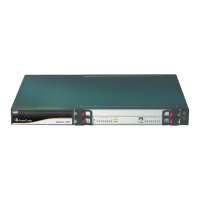Version 7.0 169 Mediant 3000
User's Manual 13. Network
Parameter Description
Source Start Port
[NATTranslation_Sour
ceStartPort]
Defines the optional starting port range (1-
65536) of the IP interface, used as
matching criteria for the NAT rule. If not configured, the match is done on the
entire port range. Only IP addresses and ports of matched source ports will
be replaced.
Source End Port
[NATTranslation_Sour
ceEndPort]
Defines the optional ending port range (1-65536) of the IP interface, used as
matching criteria for the NAT rule. If not configured, the match is done on the
entire port range. Only IP addresses and ports of matched source ports will
be replaced.
Target Start Port
[NATTranslation_Targ
etStartPort]
Defines the optional starting port range (1-65536) of the global address. If
not configured, the ports are not replaced. Matching source ports are
replaced with the target ports. This address is set in the SIP Via and Contact
headers, as well as in the o= and c= SDP fields.
Target End Port
[NATTranslation_Targ
etEndPort]
Defines the optional ending port range (1-65536) of the global address. If not
configured, the ports are not replaced. Matching source ports are replaced
with the target ports. This address is set in the SIP Via and Contact headers,
as well as in the o= and c= SDP fields.
13.9.2 Remote UA behind NAT
13.9.2.1 SIP Signaling Messages
By default, the device resolves NAT issues for SIP signaling, using its NAT Detection
mechanism. The NAT Detection mechanism checks whether the endpoint is located behind
NAT, by comparing the incoming packet's source IP address with the SIP Contact header's
IP address. If the packet's source IP address is a public address and the Contact header's
IP address is a local address, the device considers the endpoint as located behind NAT. In
this case, the device sends the SIP messages to the endpoint, using the packet's source IP
address. Otherwise (or if you have disabled the NAT Detection mechanism), the device
sends the SIP messages according to the SIP standard RFC 3261, where requests within
the SIP dialog are sent using the IP address in the Contact header, and responses to
INVITEs are sent using the IP address in the Via header. To enable or disable the device's
NAT Detection mechanism, use the 'SIP NAT Detection' parameter.
If necessary, you can also configure the device to always consider incoming SIP INVITE
messages as sent from endpoints that are located behind NAT. When this is enabled, the
device sends responses to the INVITE (to the endpoint), using the the source IP address of
the packet (INVITE) initially received from the endpoint. This is especially useful in
scenarios where the endpoint is located behind a NAT firewall and the device (for whatever
reason) is unable to identify NAT using its regular NAT Detection mechanism. This feature
is enabled per specific calls using IP Groups. To configure this feature, use the 'Always
Use Source Address' parameter in the IP Group table (see ''Configuring IP Groups'' on
page 343). If this feature is disabled, the device's NAT detection is according to the settings
of the global parameter, 'SIP NAT Detection' parameter.
13.9.2.2 Media (RTP/RTCP/T.38)
When a remote UA initiates a call and is not located behind a NAT server, the device
sends the RTP (or RTCP, T.38) packets to the remote UA using the IP address:port (UDP)
indicated in the SDP body of the SIP message received from the UA. However, if the UA is

